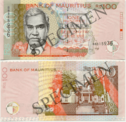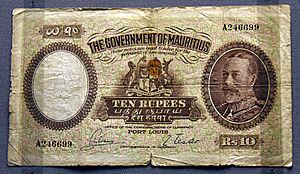Mauritian rupee facts for kids
Quick facts for kids Mauritian rupee |
|||||
|---|---|---|---|---|---|
| Roupie mauricienne (French) Roupi morisien (Morisien) மொரீசியஸ் ரூபாய் (Tamil) मॉरिशियाई रुपया (Devanagari script) |
|||||
|
|||||
| ISO 4217 Code | MUR | ||||
| User(s) | |||||
| Inflation | 4.5% | ||||
| Source | Bank in Mauritius, November 2023 est. | ||||
| Subunit | |||||
| 1⁄100 | cent | ||||
| Symbol | Re/Rs | ||||
| cent | c | ||||
| Coins | 5c, 20c, 50c, Rs. 1/-, Rs. 5/-, Rs. 10/-, Rs. 20/- | ||||
| Banknotes | Rs. 25/-, Rs. 50/-, Rs. 100/-, Rs. 200/-, Rs. 500/-, Rs. 1,000/-, Rs. 2,000/- | ||||
The Mauritian rupee is the money used in Mauritius, an island nation in the Indian Ocean. Its symbol is Re for one rupee and Rs for more than one. The international code for this currency is MUR. Just like a dollar is divided into 100 cents, one Mauritian rupee is divided into 100 cents. You might hear about other countries using a currency also called a rupee.
Contents
Coins of Mauritius
The first Mauritian coins were made in 1877. They came in values of 1, 2, 5, 10, and 20 cents. The smaller values (1, 2, 5 cents) were made of copper. The larger values (10, 20 cents) were made of silver. After 1899, no new coins were made until 1911. Silver coins didn't return until 1934. That's when coins for 1⁄4 rupee, 1⁄2 rupee, and 1 rupee were introduced.
In 1947, new 10-cent coins were made from a mix of copper and nickel. By 1950, this mix replaced silver in all coins. In 1971, a brand new set of coins was released. These coins showed Queen Elizabeth II on one side. The other side had different designs related to Mauritius.
A big change happened in 1987. For the first time, the coins did not show the Queen. Instead, they featured Sir Seewoosagur Ramgoolam, an important Mauritian leader. Mauritius became a republic in 1992, but this change on the coins happened earlier. This new set included coins like 1 cent, 5 cents, 20 cents, 1⁄2 rupee, 1 rupee, and 5 rupees. In 1997, 10-rupee coins were added.
Today, you can find 5c, 20c, 50c, Re. 1/-, Rs. 5/-, Rs. 10/-, and Rs. 20/- coins in use. Coins worth less than 1 rupee are mostly used for small change. The 1-cent coin is very rare now and is mostly collected by people who like coins. In 2007, a special Rs. 20/- coin was made. It had two different metals. This coin was made to celebrate the 40th birthday of the Bank of Mauritius. Now, it's a regular coin you can find.
Banknotes of Mauritius
The first banknotes (paper money) in Mauritius were printed in 1876. They came in Rs. 5/-, Rs. 10/-, and Rs. 50/- values. In 1919, Re. 1/- banknotes were added. During 1940, special emergency notes for 25c, 50c, and Re. 1/- were made. Later, in 1954, Rs. 25/- and Rs. 1,000/- banknotes were introduced.
The Bank of Mauritius started in 1967. Since then, it has been in charge of printing all the banknotes and making all the coins. The bank's first notes came out in 1967. They included Rs. 5/-, Rs. 10/-, Rs. 25/-, and Rs. 50/-. All these notes showed Queen Elizabeth II on the front. Over time, new versions of these notes were printed with different signatures from the Bank's leaders, but the designs stayed mostly the same.
1967 "Elizabeth II" Banknotes
| Image | Denomination | Front Design | Back Design |
|---|---|---|---|
| [1] | Rs. 5/- | Queen Elizabeth II | A monument where the Dutch landed in 1598, and a sailing boat. |
| Rs. 10/- | Government House, a famous building in Port Louis. | ||
| [2] | Rs. 25/- | A Bullock cart, a traditional way of transport. | |
| Rs. 50/- | The Port Louis Harbour, showing the busy port. |
In 1985, the Bank of Mauritius released a completely new set of banknotes. These included Rs. 5/-, Rs. 10/-, Rs. 20/-, Rs. 50/-, Rs. 100/-, Rs. 200/-, Rs. 500/-, and Rs. 1,000/-. These notes were printed by two different companies, so they had some small differences in their designs and security features. This set of notes was used until 1998.
In 1998, another new series of banknotes was issued. This time, there were 7 different values, from Rs. 25/- to Rs. 2,000/-. All these notes had a similar design and were released at the same time. However, these first banknotes were taken out of use in June 1999. This happened after some discussions about the order of the languages (English, Sanskrit, Tamil) printed on them.
The Bank of Mauritius then released its most recent series of banknotes after June 1999. These are the notes you see in Mauritius today.
Current Banknotes: What They Look Like
Front Designs
Each banknote has a picture of an important Mauritian person on the left side.
| Denomination | Person's Portrait | Small Picture (Vignette) |
|---|---|---|
| Rs. 25/- | Moilin Jean Ah-Chuen | Rodrigues island |
| Rs. 50/- | Joseph Maurice Paturau | Le Caudan waterfront area |
| Rs. 100/- | Renganaden Seeneevassen | Court House building |
| Rs. 200/- | Sir Abdool Razack Mohamed | Mauritian Market scene |
| Rs. 500/- | Sookdeo Bissoondoyal | University of Mauritius |
| Rs. 1,000/- | Sir Charles Gaëtan Duval | State House building |
| Rs. 2,000/- | Sir Seewoosagur Ramgoolam | Bull & Sugarcane Cart |
At the top of the note, it says "Bank of Mauritius". The person's picture is in the middle-left, with their name and life years below it. In the bottom-left corner, you'll see the coat of arms of Mauritius. There's also a drawing of the Bank of Mauritius building and a statue of justice in the background. The value of the note is in the top-right corner, with "Rs" before the number. Below this value, there's a special feature to help people who can't see well. Also, each banknote is a different size, which helps with telling them apart.
On the left side of the note, the numerical value is written sideways, facing up. Above this number is the note's serial number. The serial number also appears on the middle-right of the note. In the top-center, it says "This Note Is Legal Tender For", followed by the value written in English (like "One Hundred") and then "Rupees". Below that, the value is written in Tamil and then in Bhojpuri. At the bottom, you'll find the signatures of the Governor of the Bank of Mauritius and other bank officials. The year the note was printed is also shown.
Back Designs
On the back of the note, "Bank of Mauritius" is at the top left. The numerical value is written sideways on the left, just like on the front. The top right also shows the numerical value with "Rs" in front. Each banknote has a different picture on the back, showing various parts of Mauritius. The value of the note in Devanagari script (used for Hindi) is on the left side at the bottom of the picture. The values in Tamil and Gujarati are on the right side, with Tamil above Gujarati.
How to Check if a Banknote is Real
Banknotes have special features to help you know they are real.
- Feel the Paper: The paper used for banknotes has a unique feel.
- Watermark: Hold the note up to the light. You should see a clear picture of a dodo (a famous bird from Mauritius).
- See-through Feature: Look at the note against direct light. A picture of a conch shell will appear complete.
- Security Thread: When held to the light, a continuous band with "Bank of Mauritius" written on it can be seen running through the paper. When flat, you can see shiny parts on the surface.
- Raised Printing: The portrait and some other parts are printed with special ink that you can feel with your fingers.
- Hidden Image: If you hold the note at eye level and tilt it, you can see the letters "BM" (for Bank of Mauritius).
- Tiny Text: Use a magnifying glass to look closely. You'll see tiny letters "BM" that are clear to read.
- Under UV Light: If you shine an ultraviolet light on the note, numbers matching its value will glow.
For Rs. 100/-, Rs. 200/-, Rs. 500/-, Rs. 1,000/-, Rs. 2,000/- banknotes:
- Shiny Band: There's a gold-colored band that appears and disappears when you tilt the note in the light.
For Rs. 100/-, Rs. 200/- banknotes:
- Silver Ink: A dull silver metallic band runs from top to bottom on the front, on the left side. There's also a metallic strip below the value in the top right.
For Rs. 500/-, Rs. 1,000/- banknotes:
- Silver Foil: A silver foil changes between two different images (the value or a shape) when you look at it from different angles.
For Rs. 2,000/- banknote:
- Hologram: This note has a hologram with pictures of the dodo and the number "2000".
For Rs. 200/-, Rs. 500/-, Rs. 1,000/- banknotes:
- Hologram: These notes also have holograms. The Rs. 200/- has a dodo, the Rs. 500/- has a deer, and the Rs. 1,000/- has the Bank of Mauritius tower, all with their values.
For Rs. 25/-, Rs. 50/-, Rs. 500/-, Rs. 2,000/- banknotes:
- These notes have updated security features and are now made from polymer (a type of plastic) instead of paper.
Special Commemorative Coins
Mauritius also creates special coins to celebrate important events. These are often made for collectors.
| Value | Material | Weight | Diameter | Issue Date | What it Celebrates |
|---|---|---|---|---|---|
| Rs. 25/- | Silver | 38.61 g | 38.61 mm | April 1978 | 10 years since Mauritius became independent |
| Rs. 20/- | Silver | 28.28 g | 38.61 mm | May 1998 | 50th wedding anniversary of Queen Elizabeth II and Prince Philip |
| Rs. 1,000/- | Gold | 17 g | 31.00 mm | January 2000 | 150th anniversary of the Mauritius Chamber of Commerce & Industry |
| Rs. 10/- | Silver | 28.28 g | 38.60 mm | January 2000 | 150th anniversary of the Mauritius Chamber of Commerce & Industry |
| Rs. 100/- | Silver | 36.76 g | 44 mm | November 2001 | 100 years since Mahatma Gandhi first arrived in Mauritius |
| Current MUR exchange rates | |
|---|---|
| From Google Finance: | AUD CAD CHF EUR GBP HKD JPY USD EUR JPY USD |
| From Yahoo! Finance: | AUD CAD CHF EUR GBP HKD JPY USD EUR JPY USD |
| From XE.com: | AUD CAD CHF EUR GBP HKD JPY USD EUR JPY USD |
| From OANDA: | AUD CAD CHF EUR GBP HKD JPY USD EUR JPY USD |
| From fxtop.com: | AUD CAD CHF EUR GBP HKD JPY USD EUR JPY USD |
See also
- Economy of Mauritius
- Seychellois rupee
Images for kids





